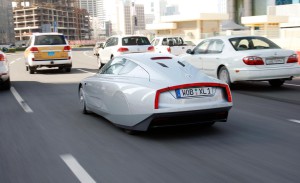 This is the Volkswagen XL1. It comes as a result of 15 years long effort of the company to build a 235 MPG car (i.e. a vehicle that can burn just one liter of fuel to travel 100 kilometers, or 62.1 miles). To me, it looks like an alien car. And I really, really want to try it out on the road. As I may not have the chance to do so soon, I went through all the reviews I could find online and the result was not what I expected. I still want to try it, but now it would take a miracle to make me buy it. But let’s go to the facts I gathered.
This is the Volkswagen XL1. It comes as a result of 15 years long effort of the company to build a 235 MPG car (i.e. a vehicle that can burn just one liter of fuel to travel 100 kilometers, or 62.1 miles). To me, it looks like an alien car. And I really, really want to try it out on the road. As I may not have the chance to do so soon, I went through all the reviews I could find online and the result was not what I expected. I still want to try it, but now it would take a miracle to make me buy it. But let’s go to the facts I gathered.
The XL1’s efficiency is already legendary: in windless conditions it needs just 8bhp to maintain a steady 62mph (100km/h) and it can return up to 313mpg (133km/l). And yet if you were to deploy all available power it would hit 125mph (200km/h), although for now it’s governed at 100mph (160km/h). The twin forces which shaped this car are weight and aerodynamics. Everything possible has been done to optimize these two and some of the things they did just made me laugh – It doesn’t have electric windows, for instance, as hand winders weigh less. Really? There are no wing mirrors as these create drag. Instead, tiny rear-facing cameras transmit an image on to a screen on the door panels – now that’s a good, futuristic idea. But why would they put the screens on the door panels? It’s not like there is something in the mirror’s place. The car has fared-in wheels, skinny tires and an entirely flat bottom.
Inside, the XL1 looks remarkably normal. The car is so radical and challenging, the team said, that they wanted the interior to be familiar, calm and uncluttered. Much of the kit is the same as you’d find in a Golf. And if I wanted to drive a Golf, I would buy a Golf. If the car looks alien, make it alien all the way.
All the things I read about this car made me realize something. Volkswagen didn’t build it to make an efficient and clean car. They did it because they could.
Under note: Electrical means clean? Where do you think electricity comes from?
